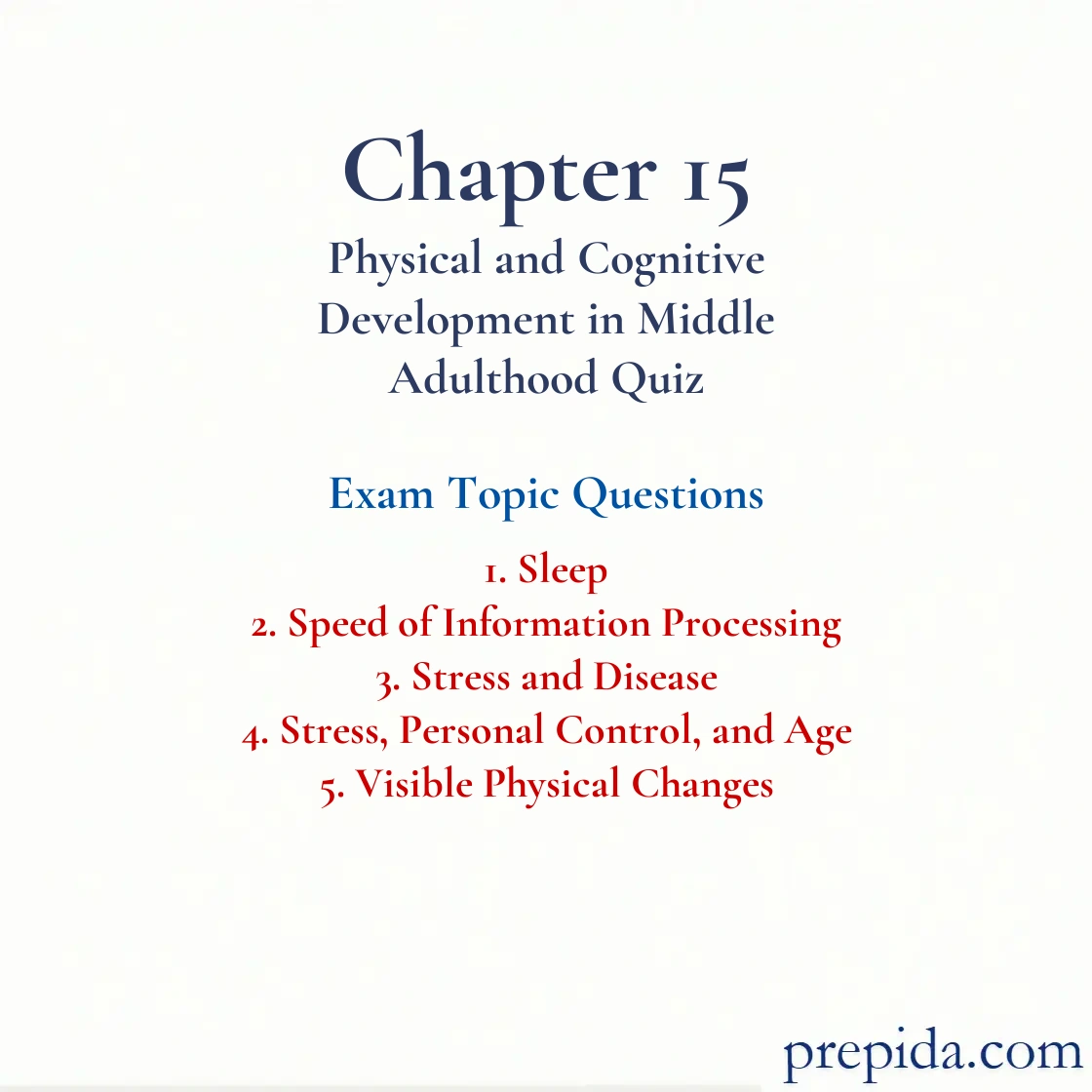
What is the most common change in sleep patterns of adults during middle age?
- Sleep-disordered breathing becomes less prevalent.
- Wakeful periods become less frequent during the night.
- The total number of hours slept dramatically increases.
- There is a decrease in the deepest type of sleep.
Which of the following is a common way to assess speed of information processing?
- reaction-time task
- phonic simulation
- visual perception test
- neuropsychological test
An adult in middle age will most likely do poorly on which of the following tasks?
- understanding verbal directions
- completing a crossword puzzle
- hitting the brakes of a car when the light suddenly turns red
- lifting a box that weighs 20 pounds
Perception: The interpretation of what is sensed.
Which of the following statements is true of the immune system and stress?
- NK cells are a type of white blood cell that is more likely to be present in high-stress circumstances.
- Higher levels of NK cells in stressful situations indicate a weakened immune system.
- Immune system functioning increases with normal aging.
- Aerobic fitness is related to the presence of a lower level of senescent T cells.
Aerobic Exercise: Sustained exercise (such as jogging, swimming, or cycling) that stimulates heart and lung activity.
Which of the following statements is true of chronic conditions?
- Women have a higher incidence of fatal chronic conditions in middle age.
- Men have a higher incidence of nonfatal chronic conditions in middle age.
- Hypertension is the leading chronic disorder in early adulthood.
- Chronic disorders are rare in early adulthood.
Chronic Disorders: Disorders that are characterized by slow onset and long duration. They are rare in early adulthood, increase during middle adulthood, and become common in late adulthood.
Which of the following are prematurely aging cells that result from persistent immune activation?
- NK cells
- red blood cells
- B lymphocytes
- senescent T cells
Which of the following statements is true of the immune system?
- Its machinery consists of billions of red blood cells.
- When a person is under stress, the levels of bacteria and viruses drop dramatically.
- Lower levels of natural killer (NK) cells in stressful situations indicate a weakened immune system.
- Stress increases the number of natural killer (NK) cells in the body.
Hormonal Stress Theory: The theory that aging in the body’s hormonal system can decrease resistance to stress and increase the likelihood of disease.
The type of white blood cell that is more likely to be present in low-stress circumstances are ________.
- plasma cells
- natural killer (NK) cells
- lymphocytes
- monocytes
Compared with men, women have a higher incidence of ________ during middle age.
- arthritis
- hypertension
- stroke
- cardiovascular disease
Arthritis: Inflammation of the joints accompanied by pain, stiffness, and movement problems; this disease is especially common in older adults.
Which of the following is an example of a fatal chronic disorder?
- varicose veins
- bursitis
- arthritis
- cardiovascular disease
Which of the following is typical of the health condition during early and late middle age?
- Frequency of accidents increases.
- Susceptibility to colds and allergies decreases.
- Wakeful periods during sleep decrease.
- Incidence of chronic disorders decreases.
Which of the following are the most common chronic disorders for men during middle age?
- cancer, heart disease, and stroke
- arthritis, bursitis, and varicose veins
- hearing and vision impairments
- sinus and respiratory problems
Chronic Disorders: Disorders that are characterized by slow onset and long duration. They are rare in early adulthood, increase during middle adulthood, and become common in late adulthood.
Compared with men, women have a higher incidence of ________ disorders during middle adulthood.
- genetic
- fatal chronic
- nonfatal chronic
- congenital
Middle Adulthood: The developmental period that begins at approximately 40 to 45 years of age and extends to about 60 to 65 years of age.
Margie Lachman and her colleagues argue that having a ________ is one of the most important modifiable factors in delaying the onset of diseases in middle adulthood and reducing the frequency of diseases in late adulthood.
- high body mass index
- sense of control in middle age
- low-calorie diet in middle adulthood
- low number of NK cells
Middle Adulthood: The developmental period that begins at approximately 40 to 45 years of age and extends to about 60 to 65 years of age.
Which of the following is a reason for the decrease in height with age advancement?
- brittleness of bones of the limbs
- increase in weight
- a stooping posture
- bone loss in the vertebrae
Osteoporosis: A chronic condition that involves an extensive loss of bone tissue and is the main reason many older adults walk with a marked stoop.
The average adult in middle adulthood ________ height and ________ weight.
- loses; loses
- loses; gains
- gains; gains
- gains; loses
Middle Adulthood: The developmental period that begins at approximately 40 to 45 years of age and extends to about 60 to 65 years of age.
Which of the following is a sign of aging for the average adult in middle adulthood?
- increase in height
- decrease in weight
- brittle fingernails
- loss of memory